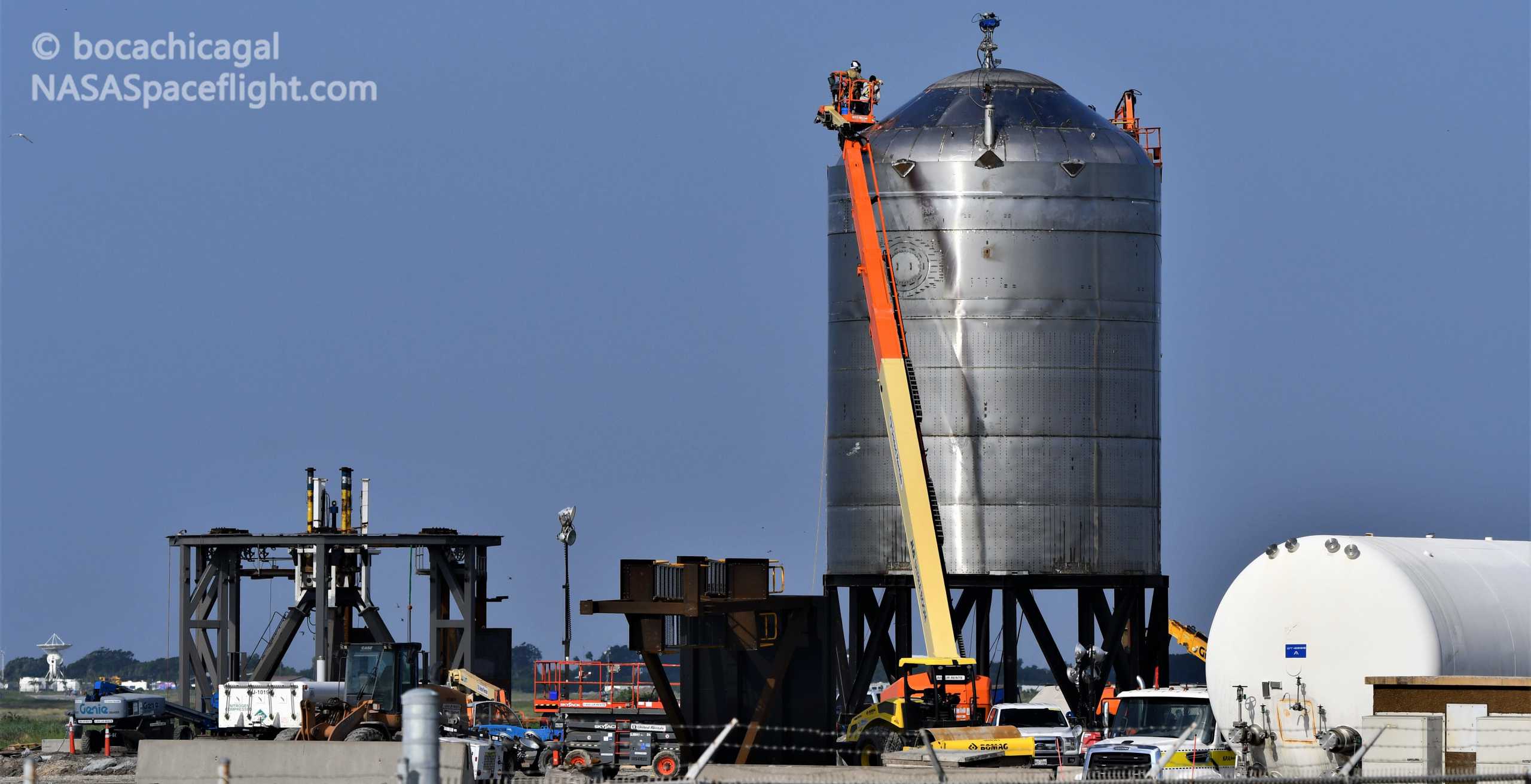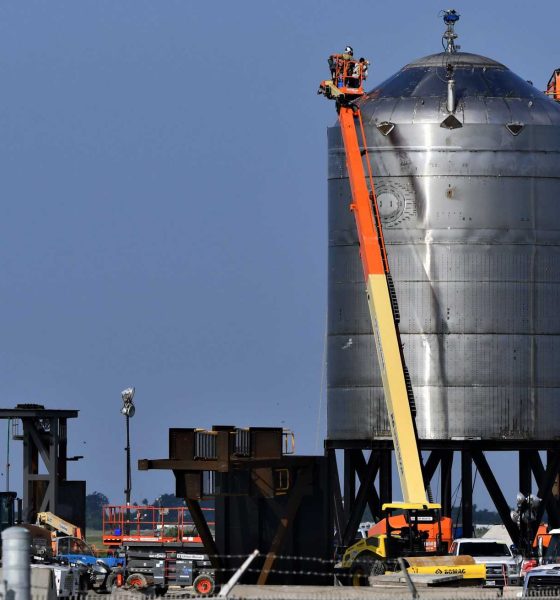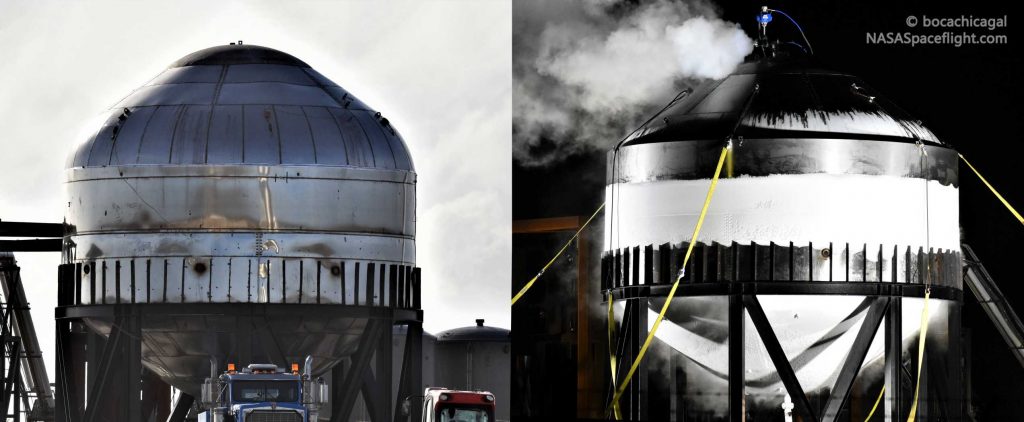

News
SpaceX Starship test tank ready for a second shot at destruction
For the fourth time ever, SpaceX is ready to destroy a Starship test tank – the results of which will \determine the next steps for Starship development.
Technically, this will be the second time SpaceX has attempted to destroy Starship test tank SN7.1 following an unsuccessful night of testing on September 17th. Following two days of back-to-back stress tests on the 14th and 15th, successfully proving that SpaceX’s newest test tank and steel alloy can withstand the rigors of suborbital launch, unknown issues scrubbed a third series of tests meant to intentionally destroy SN7.1.
Excluding Starship SN2, thus far the only test tank to survive, SpaceX’s latest intentionally destructive test campaign builds on the controlled failures of two unnamed tanks in January and Starship SN7 in June. SN7.1 is essentially a more complex version of SN7, integrating a “thrust puck” to ensure that SpaceX’s custom steel alloy is also the right choice for the puck-like structure tasked with transferring the thrust of 3-6 Raptor engines through the rest of Starship.



Theoretically, the 304L-esque alloy SpaceX has decided to replace 301 steel with should make Starships less brittle under cryogenic temperatures, meaning that a breached tank should spring leaks instead of violently bursting. That characteristic would be a boon for vehicle safety and survivability relative to almost any other rocket. With Starship test tank SN7, SpaceX has already demonstrated that its custom steel alloy will gently leak before bursting.
Simultaneously, SN7 is believed to have broken SpaceX’s internal Starship tank pressure record despite having multiple flawed welds, meaning that SN7.1 could reach even higher pressures if SpaceX has since improved build quality.
Ironically built well before test tank SN7.1, SpaceX has already completed the tank section of SN8 – the first full-size Starship to exclusively use the company’s custom steel alloy. Given that SN7.1 has already survived two full nights of nondestructive tests, it’s safe to say that SpaceX is likely happy with the tank’s performance and that the viability of 304L steel has been thoroughly vetted. In the unlikely event that any unsavory discoveries are made in the process of destroying test tank SN7.1, that might change, but the purpose of destructive tank testing is less to qualify new designs than it is to push the more abstract limits of materials and manufacturing techniques.
As previously discussed on Teslarati, it remains to be seen if SpaceX will begin testing Starship SN8 before the prototype has been fully outfitted with a nosecone, plumbed header tanks, and four flaps. If SpaceX does choose to test SN8 prior to completion, the prototype could be ready to head to the launch pad almost as soon as SN7.1 is destroyed.
SN7.1’s final test window stretches from 9pm to 6am CDT (UTC-5) on September 21st with an identical backup on the 22nd. The test will be streamed by NASASpaceflight (until SN7.1 has burst or the window has closed) and LabPadre (a 24/7 feed).
Check out Teslarati’s Marketplace! We offer Tesla accessories, including for the Tesla Cybertruck and Tesla Model 3.

News
Tesla FSD fleet is nearing 7 billion total miles, including 2.5 billion city miles
As can be seen on Tesla’s official FSD webpage, vehicles equipped with the system have now navigated over 6.99 billion miles.

Tesla’s Full Self-Driving (Supervised) fleet is closing in on almost 7 billion total miles driven, as per data posted by the company on its official FSD webpage.
These figures hint at the massive scale of data fueling Tesla’s rapid FSD improvements, which have been quite notable as of late.
FSD mileage milestones
As can be seen on Tesla’s official FSD webpage, vehicles equipped with the system have now navigated over 6.99 billion miles. Tesla owner and avid FSD tester Whole Mars Catalog also shared a screenshot indicating that from the nearly 7 billion miles traveled by the FSD fleet, more than 2.5 billion miles were driven inside cities.
City miles are particularly valuable for complex urban scenarios like unprotected turns, pedestrian interactions, and traffic lights. This is also the difference-maker for FSD, as only complex solutions, such as Waymo’s self-driving taxis, operate similarly on inner-city streets. And even then, incidents such as the San Francisco blackouts have proven challenging for sensor-rich vehicles like Waymos.
Tesla’s data edge
Tesla has a number of advantages in the autonomous vehicle sector, one of which is the size of its fleet and the number of vehicles training FSD on real-world roads. Tesla’s nearly 7 billion FSD miles then allow the company to roll out updates that make its vehicles behave like they are being driven by experienced drivers, even if they are operating on their own.
So notable are Tesla’s improvements to FSD that NVIDIA Director of Robotics Jim Fan, after experiencing FSD v14, noted that the system is the first AI that passes what he described as a “Physical Turing Test.”
“Despite knowing exactly how robot learning works, I still find it magical watching the steering wheel turn by itself. First it feels surreal, next it becomes routine. Then, like the smartphone, taking it away actively hurts. This is how humanity gets rewired and glued to god-like technologies,” Fan wrote in a post on X.
News
Tesla starts showing how FSD will change lives in Europe
Local officials tested the system on narrow country roads and were impressed by FSD’s smooth, human-like driving, with some calling the service a game-changer for everyday life in areas that are far from urban centers.

Tesla has launched Europe’s first public shuttle service using Full Self-Driving (Supervised) in the rural Eifelkreis Bitburg-Prüm region of Germany, demonstrating how the technology can restore independence and mobility for people who struggle with limited transport options.
Local officials tested the system on narrow country roads and were impressed by FSD’s smooth, human-like driving, with some calling the service a game-changer for everyday life in areas that are far from urban centers.
Officials see real impact on rural residents
Arzfeld Mayor Johannes Kuhl and District Administrator Andreas Kruppert personally tested the Tesla shuttle service. This allowed them to see just how well FSD navigated winding lanes and rural roads confidently. Kruppert said, “Autonomous driving sounds like science fiction to many, but we simply see here that it works totally well in rural regions too.” Kuhl, for his part, also noted that FSD “feels like a very experienced driver.”
The pilot complements the area’s “Citizen Bus” program, which provides on-demand rides for elderly residents who can no longer drive themselves. Tesla Europe shared a video of a demonstration of the service, highlighting how FSD gives people their freedom back, even in places where public transport is not as prevalent.
What the Ministry for Economic Affairs and Transport says
Rhineland-Palatinate’s Minister Daniela Schmitt supported the project, praising the collaboration that made this “first of its kind in Europe” possible. As per the ministry, the rural rollout for the service shows FSD’s potential beyond major cities, and it delivers tangible benefits like grocery runs, doctor visits, and social connections for isolated residents.
“Reliable and flexible mobility is especially vital in rural areas. With the launch of a shuttle service using self-driving vehicles (FSD supervised) by Tesla in the Eifelkreis Bitburg-Prüm, an innovative pilot project is now getting underway that complements local community bus services. It is the first project of its kind in Europe.
“The result is a real gain for rural mobility: greater accessibility, more flexibility and tangible benefits for everyday life. A strong signal for innovation, cooperation and future-oriented mobility beyond urban centers,” the ministry wrote in a LinkedIn post.
News
Tesla China quietly posts Robotaxi-related job listing
Tesla China is currently seeking a Low Voltage Electrical Engineer to work on circuit board design for the company’s autonomous vehicles.

Tesla has posted a new job listing in Shanghai explicitly tied to its Robotaxi program, fueling speculation that the company is preparing to launch its dedicated autonomous ride-hailing service in China.
As noted in the listing, Tesla China is currently seeking a Low Voltage Electrical Engineer to work on circuit board design for the company’s autonomous vehicles.
Robotaxi-specific role
The listing, which was shared on social media platform X by industry watcher @tslaming, suggested that Tesla China is looking to fill the role urgently. The job listing itself specifically mentions that the person hired for the role will be working on the Low Voltage Hardware team, which would design the circuit boards that would serve as the nervous system of the Robotaxi.
Key tasks for the role, as indicated in the job listing, include collaboration with PCB layout, firmware, mechanical, program management, and validation teams, among other responsibilities. The role is based in Shanghai.
China Robotaxi launch
China represents a massive potential market for robotaxis, with its dense urban centers and supportive policies in select cities. Tesla has limited permission to roll out FSD in the country, though despite this, its vehicles have been hailed as among the best in the market when it comes to autonomous features. So far, at least, it appears that China supports Tesla’s FSD and Robotaxi rollout.
This was hinted at in November, when Tesla brought the Cybercab to the 8th China International Import Expo (CIIE) in Shanghai, marking the first time that the autonomous two-seater was brought to the Asia-Pacific region. The vehicle, despite not having a release date in China, received a significant amount of interest among the event’s attendees.








